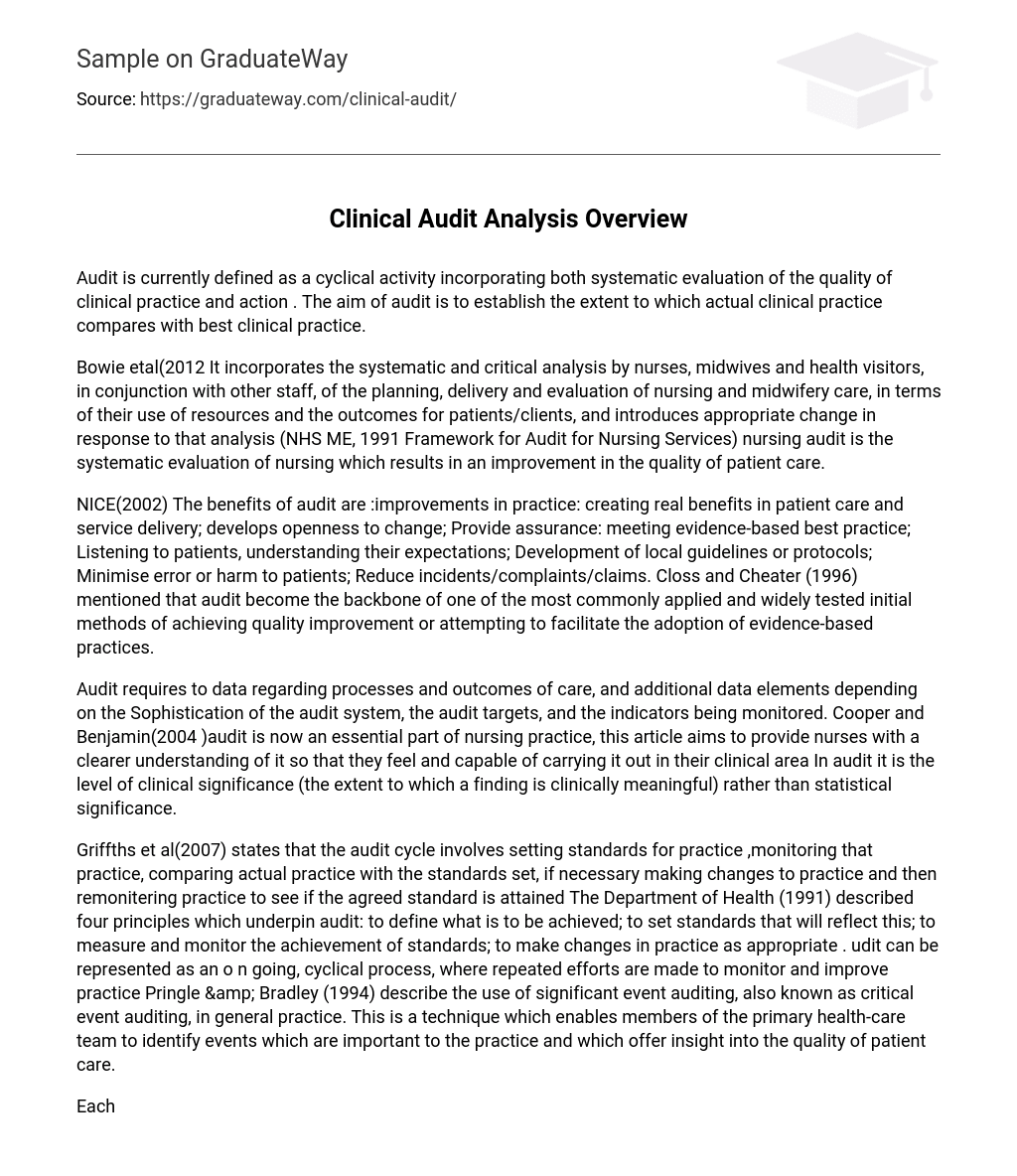Audit is currently defined as a cyclical activity incorporating both systematic evaluation of the quality of clinical practice and action . The aim of audit is to establish the extent to which actual clinical practice compares with best clinical practice.
Bowie etal(2012 It incorporates the systematic and critical analysis by nurses, midwives and health visitors, in conjunction with other staff, of the planning, delivery and evaluation of nursing and midwifery care, in terms of their use of resources and the outcomes for patients/clients, and introduces appropriate change in response to that analysis (NHS ME, 1991 Framework for Audit for Nursing Services) nursing audit is the systematic evaluation of nursing which results in an improvement in the quality of patient care.
NICE(2002) The benefits of audit are :improvements in practice: creating real benefits in patient care and service delivery; develops openness to change; Provide assurance: meeting evidence-based best practice; Listening to patients, understanding their expectations; Development of local guidelines or protocols; Minimise error or harm to patients; Reduce incidents/complaints/claims. Closs and Cheater (1996) mentioned that audit become the backbone of one of the most commonly applied and widely tested initial methods of achieving quality improvement or attempting to facilitate the adoption of evidence-based practices.
Audit requires to data regarding processes and outcomes of care, and additional data elements depending on the Sophistication of the audit system, the audit targets, and the indicators being monitored. Cooper and Benjamin(2004 )audit is now an essential part of nursing practice, this article aims to provide nurses with a clearer understanding of it so that they feel and capable of carrying it out in their clinical area In audit it is the level of clinical significance (the extent to which a finding is clinically meaningful) rather than statistical significance.
Griffths et al(2007) states that the audit cycle involves setting standards for practice ,monitoring that practice, comparing actual practice with the standards set, if necessary making changes to practice and then remonitering practice to see if the agreed standard is attained The Department of Health (1991) described four principles which underpin audit: to define what is to be achieved; to set standards that will reflect this; to measure and monitor the achievement of standards; to make changes in practice as appropriate . udit can be represented as an o n going, cyclical process, where repeated efforts are made to monitor and improve practice Pringle & Bradley (1994) describe the use of significant event auditing, also known as critical event auditing, in general practice. This is a technique which enables members of the primary health-care team to identify events which are important to the practice and which offer insight into the quality of patient care.
Each member of the team select s one such event for discussion, and where appropriate, decisions are made and actions agreed. The questions or aims of an audit are usually specific to a particular setting and motivated by local circumstances. Often it is prompted by perceived or actual defiencies in care, or the need to setup a new service. In audit standards are set for clinical practice with the explicit aim of attaining The issue of rigour in the conduct of audit then, inevitably is raised. While acknowledging the constraints in carrying out audit, Nixon (1992stresses the need for methodological rigour if audit is to change health-care practices.
Reference .Batty,G. M, Grant R. L, Potter . J. M[2004] National clinical sentinel Audit of Evidence based prescribing for older people Journal of evaluation in clinical practice 10(2), 273-279 Closs ,S . J ;Cheater, F. M;[1996] Audit or Research- what is the difference? Journal of clinical Nursing ,l5[4]249-256 Cooper J, Benjamin M (2004) Clinical audit in practice. Nursing Standard. 18, 28,47-53. Pringle M, Bradley C (1994) Significant event auditing: a user’s guide. Audit Trends. 2, 1, 20-23. .Griffiths,Paul; Debbage,Samantha;Smith,Alison; [2007] A Comprehensive audit of nursing record keeping practice British journal of nursing, 16( 21),1324-1327. 4p NICE (2002 Principles for Best Practice in Clinical Audit Radcliffe Medical Press Paul Bowie, Nicholas A. Bradley, Rosemary Rushmer, (2012) Clinical audit and quality improvement – time for a rethink? Journal of Evaluation in Clinical Practice,18(1),42-48





